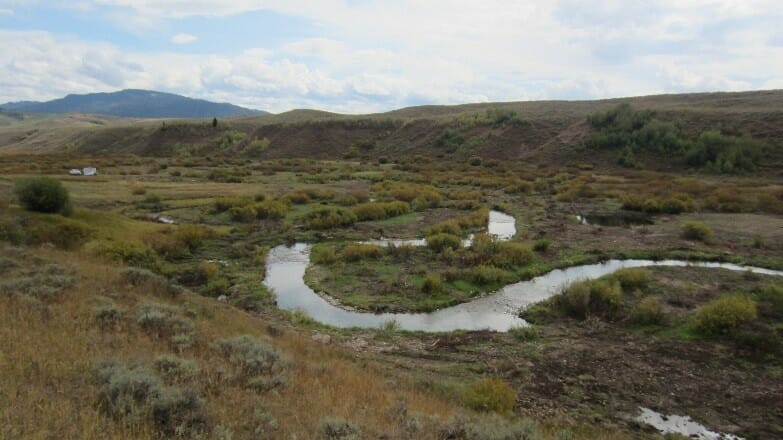Trout Unlimited and the Caribou-Targhee National Forest announced today that the Tincup Creek Stream Restoration Project’s second phase is currently under way in eastern Idaho. The project is a large-scale, multi-phased project begun in 2017 to improve ecosystem function and habitat for native cutthroat trout and other native fish species on four miles of degraded stream on the Caribout National Forest.
Implementation of the project’s second phase is ongoing and will last through Sept. 30. Future phases are anticipated in 2019 and 2020.
The Tincup Creek project area is located between Wayan, Idaho, and Freedom, Wyo., in southeast Idaho. Tincup Creek within the project area has been impaired and degraded for more than 60 years, with the primary cause of the degradation linked to aerial spraying of willows in 1956. The loss of willows precipitated the destabilization of the stream and led to the loss of meander bends and stream length, steepened gradients, channel downcutting, and an unhealthy, disconnected floodplain and riparian zone.
The second phase of the project will continue to improve riparian conditions and habitat for Yellowstone cutthroat trout, northern leatherside chub, boreal toad, western pearl shell mussels and pilose crayfish, which are all native species with special management emphasis, as well as native longnose and speckled dace, sculpin, reside shiners, and mountain suckers. Because of this native species assemblage, and Tincup Creek’s identification as a high-priority watershed in a multispecies conservation assessment of the Upper Snake River Basin, the project was named in 2017 as one of 10 Waters to Watch nationally by the National Fish Habitat Partnership. However, pre-project fish monitoring documented low densities of primarily adult trout, indicating poor habitat complexity for juvenile trout and smaller native fishes and the need for habitat restoration.
“It’s exciting to be restoring an area where we know what past activities led to its decline. To make large changes that benefit an area takes many willing partners,” said Lee Mabey, a fisheries biologist for the Caribou-Targhee. “It’s been gratifying to see all the partners that have joined together to make a difference in this very unique system as evidenced by all the native species that exist here.”
The project’s goals are to restore stream-channel and floodplain processes and function to allow for all parts of the aquatic system to interact with each other. Restoration techniques include building floodplain benches, transplanting whole willows, reconnecting historic meanders, adding large woody debris, elevating riffles for floodplain reconnection, and reinforcing naturally-occurring beaver dams. These techniques will be carried out by heavy equipment operators experienced in stream restoration work. Phase 2 of the project started the week of July 16, and will restore 1.6 miles of stream. Phase 1 of the project, completed in 2017, restored 1.9 miles of stream. In addition, volunteers from local TU chapters based in Idaho Falls, Star Valley and Jackson Hole will assist with the restoration effort in fall 2018, as they did previously in fall 2017.
The Tincup Creek Stream Restoration Project has received funding to date from the U.S. Forest Service, Desert Fish Habitat Partnership, Jackson Hole One Fly, Jackson Hole TU chapter, National Forest Foundation, Snake River Cutthroats TU chapter, TU’s Embrace-a-Stream Grant Program, U.S. Fish and Wildlife Service – Idaho, and the Western Native Trout Initiative. Additional in-kind support has been provided by Agrium, Bear Lakes Grazing Association, Caribou County, Idaho Department of Fish and Game, Idaho Transportation Department, and the Star Valley TU chapter.
“It’s been rewarding to work with all of our partners to restore native fisheries and stream health on Tincup Creek,” said Leslie Steen, director of TU’s Snake River Headwaters Home Rivers Initiative. “The project is happening on our public lands, on the national forest, so anyone is welcome to stop by and see the work first-hand. You can already see the positive changes in the stream from Phase 1, including evidence of spawning native trout, and we look forward to continuing this good work in Phase 2.”
The Tincup Creek Stream Restoration Project is a project of TU’s Snake River Headwaters Home Rivers Initiative, an ambitious initiative to restore and protect the headwaters of the Snake River and its fishery, together with a diverse group of community, landowner, and agency partners.



